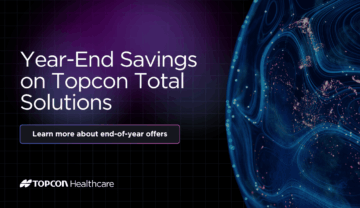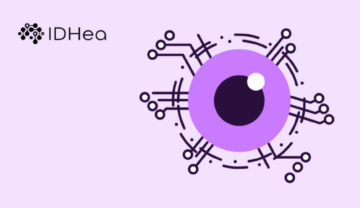Reimagine Refraction With Topcon’s Chronos Digital Refraction System
In the United States today, an aging population accompanied by a digital screen-based modern lifestyle creates growing demands for refractive vision treatment. At the same time, insurance reimbursement for services at optometry offices has been dropping in recent years. There is a pressing need to increase productivity at many practices to meet surging demands and maintain financial stability. For offices that are already operating at full capacity, new technical advancements help to increase efficiency without compromising care.
Incorporating the latest intelligent design, Topcon’s Chronos is a digital binocular refraction system that combines automated refraction, subjective refraction, keratometry, and acuity testing capabilities in one compact device. The automated refraction function improves clinical workflow by allowing technicians to conduct the machine-guided refractive evaluation as a part of pre-test.
As a long-term Topcon user, I recently added the Chronos refraction system in several of our offices. Since these new additions, the team has been impressed by the improved efficiency in the clinical workflow, which enabled more patients to be cared for while granting additional time for our providers to focus on medical eye care. Here, I will share our experience using Chronos, particularly focusing on its impact on clinical workflow, patient care, user experience, and staff satisfaction.
Since incorporating Chronos into our workflow, we found it has resulted in a better overall customer experience. Patient surveys consistently show that Chronos gets high marks on customer satisfaction. Patients are particularly impressed that technicians can now perform the complicated process of refraction, which traditionally was a specialty of optometrists.
Improving Office Workflow
Many optometry offices experience significant demand for patient visits, which makes efficiency enhancement a priority. In all the offices where we incorporated Chronos, our schedules were typically booked full for at least one month. One major bottleneck contributing to this issue is the limited number of patients each provider can see daily.
In a conventional office, optometrists perform all the refractions, which take a substantial amount of the overall time with each patient. Not only is conducting refraction a time-consuming task for the provider, but it also reduces care quality by demanding a portion of the provider’s time to be reserved for prescription acquisition.
An automated refraction system like Chronos fundamentally changes this setup by allowing trained technicians to conduct the guided refraction procedure through a series of simple touch-screen user prompts (Figure 1). Chronos further streamlines the refraction process by supporting binocular evaluation in automated and subjective modes.
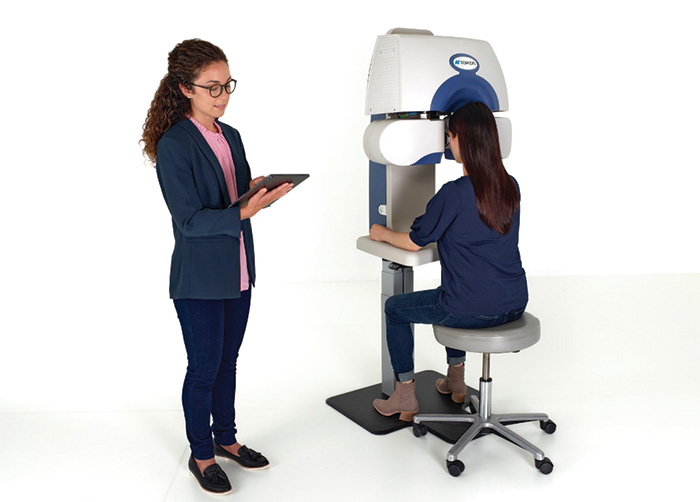
In our current workflow, doctors enter the examination lane once the automated process is completed, then briefly refine the refraction as needed. Next, we typically use the digital phoropter functionality to confirm the prescription, followed by a face-to-face discussion with the patient to complete their visit.
In this setup, staff typically take about the same amount of time conducting the refraction measurement using Chronos as refraction by the doctors, but the ability to delegate this task significantly improved our overall clinical efficiency.
In our experience, adding Chronos contributed to considerable time savings for our providers. After the incorporation of Chronos, each of our doctors added, on average, two additional full examinations per day, which is equivalent to approximately a 10% increase in our patient volume. While the changes may seem small initially, the accumulated improvements in patient management have been very meaningful to our offices. Chronos allows us to support a greater number of patients while maintaining a high standard of care.
Elevating Patient Care
At first glance, spending less time with each patient may be perceived as an unfavorable development, but the time spent is much more impactful from the patient’s perspective. Compared to the conventional workflow, Chronos allows our providers to spend less time deriving the prescription and more time answering questions and discussing treatment plans with patients. For example, Chronos frees up time to talk more about specific medical conditions such as dry eye, cataract, and headache. Since optimizing patient’s vision and eye health is the ultimate goal of our profession, maximizing the time spent focusing on their needs is certainly a welcome development.
Patients prioritize their time now more than ever. We live in an era when patients are unwilling to spend hours in the doctor’s office, where long wait times or examinations can frequently lead to a negative review. Therefore, a short visit where time is efficiently used is a positive outcome of improved efficiency. Automated refraction by Chronos allows our team to provide the best patient care while meeting the patient’s desire to prioritize their time.
When I first incorporated Chronos into my practice, there were concerns that some patients who are used to doctor-led refraction would be less receptive to automated refraction performed by technicians. However, in practice, not one of our patients asked for subjective refraction when presented with the option of automated refraction. To our surprise, customers readily accepted automated refraction by Chronos.
One key to our success is consistent messaging that automated refraction by Chronos is state-of-the-art technology. While the automated system is excellent at deriving accurate refraction results, our providers provide additional reassurance to the patients that the machine-generated results are manually evaluated and refined where needed before being finalized for their prescription. Patients feel comfortable knowing that doctors are still in charge of evaluating and determining their final prescription.
Since incorporating Chronos into our workflow, we found it has resulted in a better overall customer experience. Patient surveys consistently show that Chronos gets high marks on customer satisfaction. Patients are particularly impressed that technicians can now perform the complicated process of refraction, which traditionally was a specialty of optometrists.
Ultimately, it is humbling to me as an optometrist that patients do not miss being refracted by a doctor. I used to think our ability to perform refraction is integral to the identity of our profession. However, providers need to realize that their talent in listening to and providing the appropriate care for each patient’s unique situation is more valuable than their ability to perform refractions.
High-Quality Refractions
With any automated process, a major concern is whether the quality of automated refraction is comparable to subjective refraction. In our experience, Chronos improves efficiency in patient care without compromising the quality of refraction. I have found that the results of the automated refraction by Chronos are very accurate and comparable to subjective refraction. Since switching to the automated setup, we have not noticed any increase in cases of glasses remakes or patient complaints.
Chronos also retains the convenience of a digital phoropter, particularly the ability to provide side-by-side comparisons of old and new prescriptions. In our experience, approximately 90% of the patients pick the results produced by Chronos over their old prescription.
User-Friendly Interface
To make the device easy to use, Chronos is accompanied by SightPilot®, a guided refraction software that combines step-by-step instructions and user prompts to walk the operator throughout the entire refraction process (Figure 2). The software is highly programmable and has added flexibility that allows Chronos to be easily adjusted to accommodate the existing clinical workflow. Additionally, data obtained on Chronos can be quickly delivered to other equipment on the same network, allowing providers to view results with ease.
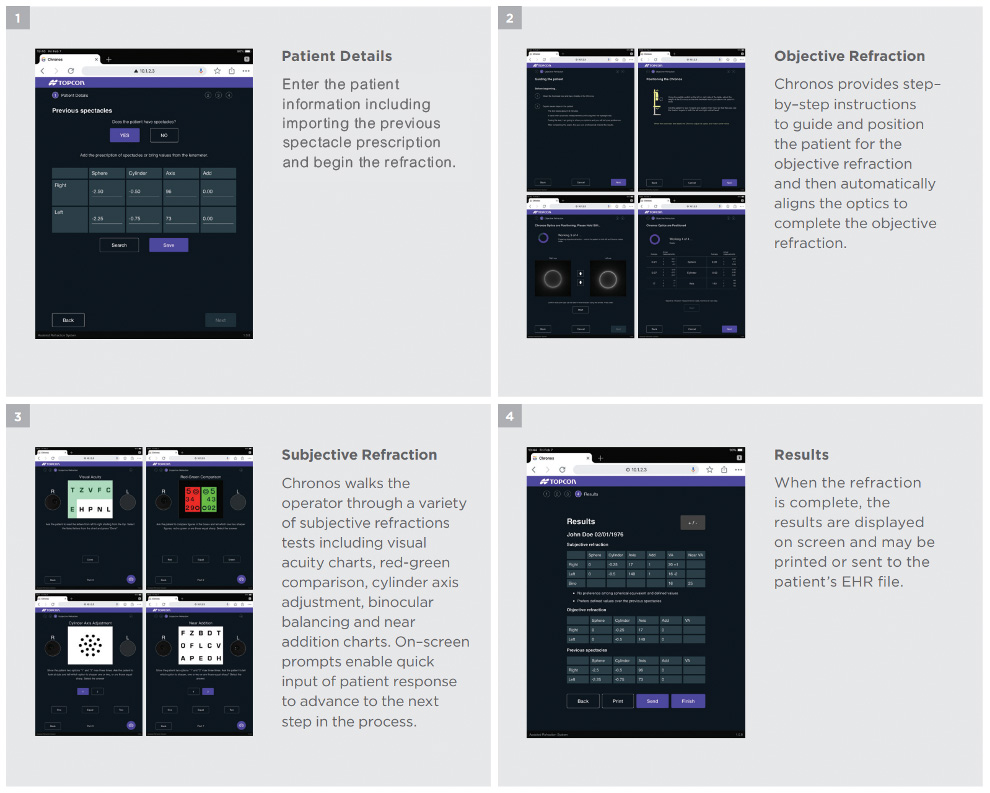
Navigating the user interface is also straightforward, which makes Chronos fast and easy to use. Users can choose to control Chronos wirelessly from various mediums, including tablets, laptops, and desktop computers.
The low learning curve is important as this allows us to train multiple technicians on the operation of Chronos. This redundancy is particularly beneficial when team members need to take time off, and another staff member can readily take over the responsibility of refraction, ensuring a smooth and efficient clinical environment.
Chronos also sports a surprisingly small footprint despite its breadth of functionalities. The entire setup takes up less than four feet of space, which greatly benefits smaller offices.
As a comprehensive optometry practice, our offices regularly see patients of all ages and physical capabilities. Chronos is designed with patient accessibility in mind, and we found it can comfortably accommodate handicapped and pediatric patients (Figure 3). These patients benefit from the multi-function capability that reduces the need to move between instruments during their visit.
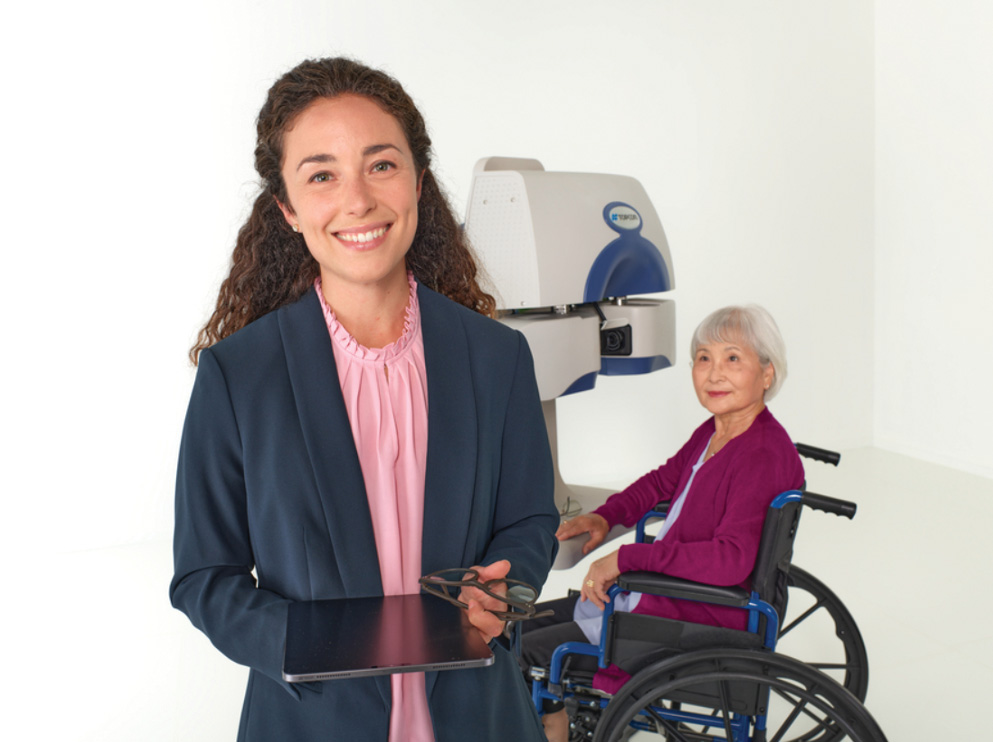
Attracting Talent
Today’s labor market is highly competitive, and optometrist offices are no exception. Incorporating the latest diagnostic instruments can improve efficiency and reduce the burden of staff shortage. In our experience, the addition of Chronos in our practice did not take a provider’s place, but it helped us maintain patient volume even when short-handed.
As well, talented people are naturally attracted to work environments equipped with the latest technology, which is one of the reasons that convinced our team to integrate Chronos into our offices. The addition of cutting-edge technologies such as Chronos has helped set us apart in attracting and retaining both providers and ancillary team members.
In addition, our technicians value being an integral part of the examination, giving them a sense of pride in their work. As a result, we have seen minimal staff turnover in the past few years.
Interacting with Topcon
As a long-time user of Topcon products, I found the company has been exceptional in delivering a high level of customer service both before and after purchase. During our purchase of Chronos, the Topcon team has been extremely helpful throughout the onboarding process. In addition to the initial training, our local Topcon representative joined the team two weeks later for a targeted training meeting to address any remaining questions that came up during the initial usage.
Due to my previous experience with Topcon, I had a lot of confidence when my local Topcon representative first approached me about Chronos. The decision to add the automated refraction system to my offices was made easy knowing the high quality typically associated with Topcon machines. After a successful trial round in one of our offices, we decided to add additional Chronos machines in other offices that would benefit from improvements in efficiency.
Purchasing a New Refraction System
Refraction is one of the most critical parts of a comprehensive eye examination. As a result, many providers have long resisted giving up performing refraction procedures. Yet, as refractive technology advances and becomes more accurate, Chronos demonstrates it is desirable to delegate refraction to trained technicians and let the providers spend more time engaging with patients on education and medical services.
For providers interested in adding Chronos to their practice, I highly recommend that you go through two processes. First, engage and obtain references from other high-volume providers. One way to do this is by talking to your local Topcon representative and getting a list of two to three doctors who run similar practices. It is vital to assess any new machine’s performance in real-life usage and evaluate the pros and cons before any major purchase.
Next, bring the team on board before the purchase. In the case of an automated refraction system, this is particularly important since the automatic process will essentially transfer refractive responsibility from the doctors to the technicians. Generally, it is important to discuss some of the issues the internal team and the patients are currently experiencing and how the new technology can help address these pain points.
After knowing how the new technology will improve workflow and care, teams will likely be more receptive to embracing the introduction of new machines. It is often a challenge to change established procedures, but once people understand the reasons behind the changes and how they can benefit from them, they will be more excited to innovate.
Incorporating Chronos into our offices has radically transformed our clinical workflow to be more streamlined and efficient. By delegating refraction to the ancillary team members, Chronos allows providers to spend more time with patients to discuss eye care. We found that patients are very receptive to automated refraction by Chronos, while the care team members are satisfied by the accurate refractions and a user-friendly interface. Optometry offices looking to improve productivity and differentiate themselves from other competitive practices should consider incorporating Chronos into their workflow.
Susan Keene, OD, is the owner of Envision Eyecare in Marion, Virginia. To contact her: [email protected]


